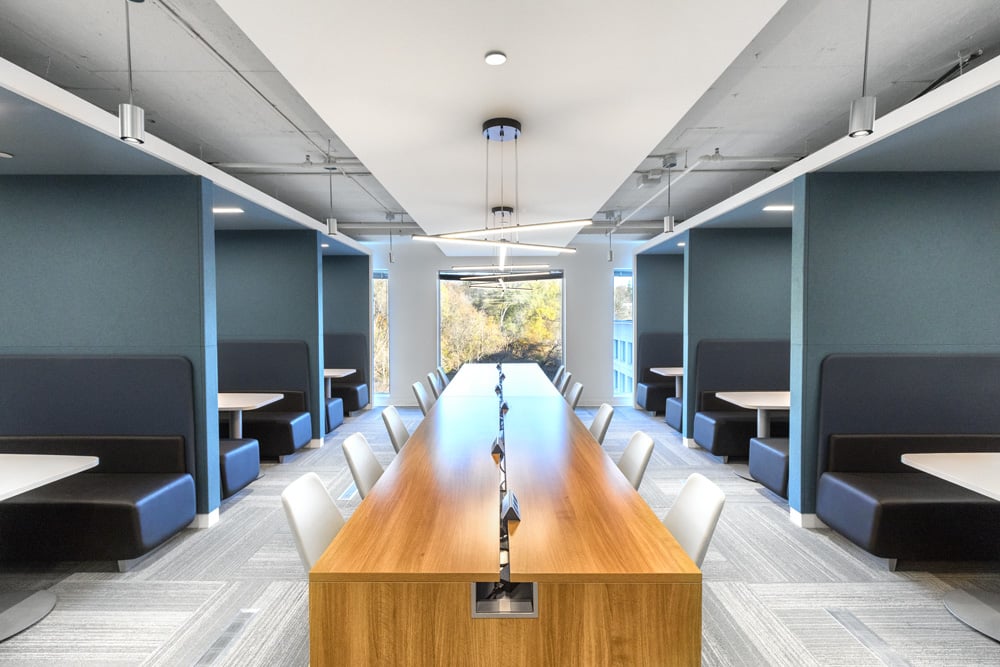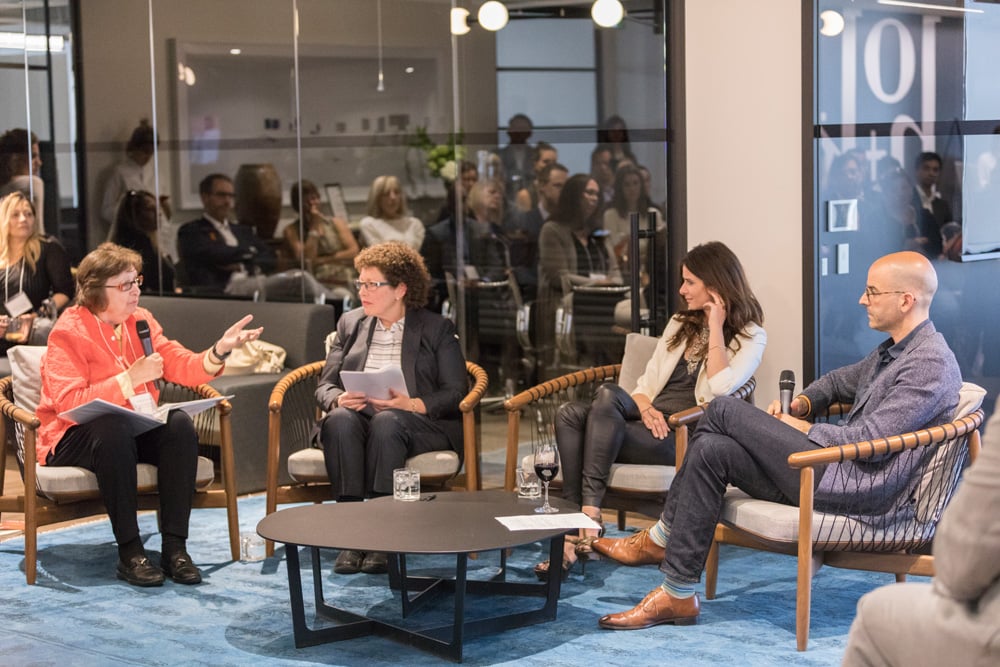
July 27, 2017
How the Information Age Is Changing Where and How We Work
Susan S. Szenasy talks with HOK Toronto, Martin & Guerin Design Research, and DEST Collective on the culture of coworking spaces that emphasize independence and flexibility while cultivating community.

For the past three years, Metropolis’s director of design innovation, formerly publisher and editor in chief, Susan S. Szenasy, has been leading a series of discussions with industry leaders on important issues surrounding human-centered design. On June 7, at HOK in Toronto, Szenasy and panelists from HOK Toronto, Martin & Guerin Design Research, and DEST Collective explored the culture of coworking spaces that emphasize independence and flexibility while cultivating community. The panelists also discussed how technology impacts workplaces, the people within them, and the architects and interior designers who conceive them. The conversation was sponsored by DuPont Surfaces, DXV/GROHE, Keilhauer, Shaw Contract, and Sunbrella Contract Fabrics. What follows is an edited transcript of the conversation, prepared by S.T. White.
Susan S. Szenasy, director of design innovation, formerly publisher and editor in chief, Metropolis (SSS): The dramatic changes in the way we work in the digital age manifest themselves in culture and behavior globally. I’d like Anthony to help contextualize these changes.
R. Anthony Fieldman, senior vice president, design principal, HOK Toronto (RAF): There is such a fundamental shift in workplace technologies that from the time we started talking about this topic today, there’s already new ground.
In the digital or information age, social cohesion is broad because it is global, but it is also shallow. Our offices, schools, friends, lovers, and families are in our pockets, and this phone is the unit of change that has shifted everything.
Workplaces have begun to emulate the network. They’re flexible, distributed, on demand, and responsive in real time, which is transforming leasing and ownership morals. For example, Convene is a company that provides event venues on demand as extensions of office spaces. WeWork wants to design your workplace and continue to operate it. There’s also a company called Quest, which is taking 190 coworking spaces in New York City and acting as a real-time Realtor. Through an app, you can book a conference room.
The network enables entrepreneurship via universal access to resources and minimizes operational footprints, which is especially beneficial for solopreneurs and small start-ups. At the end of 2016, there were 10,000 coworking spaces, representing 49 percent annual growth.
Meanwhile, the workforce is looking for things like mentorship, social cohesion, clarity of vision, trust within the workplace, open communication, and transparency. Each of these contributes to emotional health. Desirable workplaces feel like home, serve like a hotel, engage like a school or coffeehouse, support like a parent, and occasionally disengage like a library. But they have to be all of those things at different times of day for various people.
SSS: I’d like to ask Anya, an entrepreneur, and Caren, who works on evidence-based design, to share their perspectives on workplace innovations.
Caren S. Martin, principal, Martin & Guerin Design Research, LLC (CM): After about 20 years of practicing design in multidisciplinary firms, I was walking around with a client looking at a new building at a new school, saying, “The students are happier. Retention has gone up. The staff has improved.” And then I realized, the school had been open six weeks. How do we know this? It was such a pivotal moment that I spent the next 20 years working on evidencebased design, where we integrate evidence into the design process. We use research, journal articles, and studies that have been done through a systematic inquiry.
One question that strikes me is, what is it in coworking spaces that people are really flocking to? The technology that allows people to work anywhere anytime has created a huge sense of isolation.
It is anticipated that over one million people will be in coworking spaces this year. People seek social support. The research so far is not showing that people in coworking spaces have actually become more productive, but that they are feeling much better about what they’re doing. A lot of literature talks about how coworking is working alone together. It became clear that we have to provide a person—whether they’re called a host, manager, or maintainer—who makes sure that a coworking space has a social life, like event programming, and a deliberate communal culture.
Anya Pechko, founder, DEST Collective (AP): I was a broker for many years in New York and then ran a digital agency. Then, about three years ago, I moved into a suburban environment. People run businesses out of their homes with no access to human capital. Many changes in cities have yet to reach suburban markets, so it can be harder for companies in suburbs to gain traction.

SSS: What does your research suggest about coworking as a trend or an interim solution?
CM: Most people working in these spaces are between 18 and 30 years old. They don’t want to be controlled. They don’t want to be told where to work or who to work for.
Another question I continue to ask is, what can we learn from coworking environments to take back to the traditional office? There’s an estimate that in 2020, over 40 percent of U.S. workers will be freelancers or independent contractors.
RAF: Clearly, coworking is not a trend. It answers a fundamental shift in the workplace enabled by digital networking. Traditional, everything-in-house workplaces only work for dominant players with capital to invest into the space and still remain profitable. Successful coworking spaces address the needs for community, often centered on food and a robust set of activities that offer opportunities to engage the people around you.
AP: My experience in the suburbs is that unless you have kids, it’s very hard to make connections. I wanted to go to WeWork, but there isn’t one in town. Even for mothers whose kids have grown up, community can be elusive. Perhaps owing to my upbringing in Communist Russia, I think that as an individual you can make a dent in the world, but as a collective you can impact things in a bigger way. In the city, places like NeueHouse and Soho House provide platforms where people physically have access to each other, acting like think tanks. Coworking requires more than sharing a desk and flourishes the most when there are curated interests that inspire people and keep them curious.
SSS: What have employers learned from these changes?
CM: One thing that sets these spaces apart from traditional employers is there might not be any face-to-face communication with leadership. How do employees stay motivated? Is the manager of the space also forming mentor relationships, which would help young people build their confidence, mature, and become more successful?
Traditional management styles have loosened. Enforcing homogenous corporate culture is less important and there is a lot of talk about serendipity. In fact, a lot of corporations have developed coworking spaces either within their environment or off-site in different cities, knowing that their employees travel a lot. I’m curious about why some design concepts, like activitybased workplaces with a range of seating areas, work better in coworking spaces rather than company environments.

SSS: How do you design for these dynamics?
RAF: I advocate a loose fit for different forms that can transform throughout the day. Spaces can be customized, personalized, and feed different aspects of our hunger, our need for social engagement, privacy, and standing up. In the digital age, we need tangible, analog things to contrast our intensely digital communications.
One of the most interesting observations while spending years in one of these spaces with my own company was that sitting down at a desk and producing something was a very small percentage of what constituted work. Ninety percent of work happened over coffee or a quick meeting for two seconds looking at a screen. It wasn’t a bunch of “production,” but a bunch of enabling and connecting the dots instead. In the design world we talk about serendipity as productive collisions, unscripted meetings between people that a loose design allows for.
We strive for authentic experiences, which is why I think offices need to feel like home. In libraries, people are coworking around big tables. That is a fundamental and flexible component we can design around. A desk can be for one person, a meeting, or for several people to work independently.
SSS: We’re talking about an entirely different culture for the 21st century. Designing for interconnected people is a new task. Spaces are networked, trackable by a live app, accommodate increased mobility and travel, and allow more risk-taking. The spaces designed for these ways of working must reflect that, and perhaps simpler solutions are the most flexible.
CM: I implore designers and architects to take a moment to actually measure outcomes. We should set measurable goals before designing a space. That will increase the value of design and help people see the correlation between design and behavior and overall well-being.
AP: If an employee is happy, they produce better work and want to be at work. They become the brand, and retention goes up. One of the things we want DEST to do is create an elevated experience, where someone deliberately encourages people to connect with each other. People can work out of their home whether they live in the suburbs or a city. What we have to do is create something so interesting that people want to shower, get dressed, and go to an office they really like.
RAF: The flexibility of being able to respond in real time to space needs has nothing to do with design per se but everything to do with responding to needs as they arise. As the digital network becomes more pervasive and seamless, we will see more organic self-organization that humans are so good at, while technology continues to perform rote tasks.

Audience Member: How do we encourage corporate organizations to prioritize well-being? Can designers play a role in helping companies look at factors other than the bottom line?
RAF: The idea that employers should trust their employees is not a design problem but rather an institutional or cultural issue. Employers could build trust in their employees by measuring outcomes rather than hours.
CM: A lot of research says that people who work in their own time and place are actually overworking and outperforming their counterparts obligated to stay in an office. One thing a designer can do is bring that knowledge from unbiased sources, like research journals.
Audience Member 2: We talked about ditching our pajamas to find a coworking space, but what about the middle ground where condos include coworking spaces as an amenity?
AP: Every new residential building that is coming up in New York City and the surrounding area now offers a coworking space, but I think they will only succeed if they are well curated, inspiring, and relevant. Even the new Delta terminal at JFK is set up like a coworking space, with high bars and plug-ins. People work in different ways now. A lot of what we do takes the same form as work.





